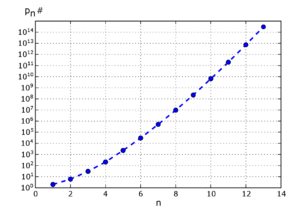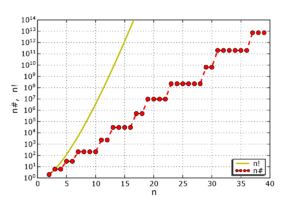Primorial


In mathematics, and more particularly in number theory, primorial is a function from natural numbers to natural numbers similar to the factorial function, but rather than successively multiplying positive integers, only prime numbers are multiplied.
There are two conflicting definitions that differ in the interpretation of the argument: the first interprets the argument as an index into the sequence of prime numbers (so that the function is strictly increasing), while the second interprets the argument as a bound on the prime numbers to be multiplied (so that the function value at any composite number is the same as at its predecessor). The rest of this article uses the former interpretation.
The name "primorial", coined by Harvey Dubner, draws an analogy to primes similar to the way the name "factorial" relates to factors.
Definition for primorial numbers
For the nth prime number pn, the primorial pn# is defined as the product of the first n primes:[1][2]
- ,
where pk is the kth prime number. For instance, p5# signifies the product of the first 5 primes:
The first five primorials pn# are:
The sequence also includes p0# = 1 as empty product. Asymptotically, primorials pn# grow according to:
where o( ) is Little O notation.[2]
Definition for natural numbers
In general for a positive integer n, a primorial n# can also be defined, namely as the product of those primes ≤ n:[1][3]
- ,
where π(n) is the prime-counting function (sequence A000720 in the OEIS), giving the number of primes ≤ n. This is equivalent to:
For example, 12# represents the product of those primes ≤ 12:
Since π(12) = 5, this can be calculated as:
Consider the first 12 values of n#:
- 1, 2, 6, 6, 30, 30, 210, 210, 210, 210, 2310, 2310.
We see that for composite n every term n# simply duplicates the preceding term (n − 1)#, as given in the definition. In the above example we have 12# = p5# = 11# since 12 is a composite number.
Primorials are related to the first Chebyshev function, written ϑ(n) or θ(n) according to:
Since ϑ(n) asymptotically approaches n for large values of n, primorials therefore grow according to:
The idea of multiplying all known primes occurs in some proofs of the infinitude of the prime numbers, where it is used to derive the existence of another prime.
Applications and properties
Primorials play a role in the search for prime numbers in additive arithmetic progressions. For instance, 2236133941 + 23# results in a prime, beginning a sequence of thirteen primes found by repeatedly adding 23#, and ending with 5136341251. 23# is also the common difference in arithmetic progressions of fifteen and sixteen primes.
Every highly composite number is a product of primorials (e.g. 360 = 2 × 6 × 30).[5]
Primorials are all square-free integers, and each one has more distinct prime factors than any number smaller than it. For each primorial n, the fraction φ(n)/n is smaller than it for any lesser integer, where φ is the Euler totient function.
Any completely multiplicative function is defined by its values at primorials, since it is defined by its values at primes, which can be recovered by division of adjacent values.
Base systems corresponding to primorials (such as base 30, not to be confused with the primorial number system) have a lower proportion of repeating fractions than any smaller base.
Every primorial is a sparsely totient number.[6]
The n-compositorial of a composite number n is the product of all composite numbers up to and including n.[7] The n-compositorial is equal to the n-factorial divided by the primorial n#. The compositorials are
Appearance
The Riemann zeta function at positive integers greater than one can be expressed[9] by using the primorial function and Jordan's totient function Jk(n):
Table of primorials
| n | n# | pn | pn#[10] | Primorial prime? | |
|---|---|---|---|---|---|
| pn# + 1[11] | pn# − 1[12] | ||||
| 0 | 1 | N/A | 1 | Yes | No |
| 1 | 1 | 2 | 2 | Yes | No |
| 2 | 2 | 3 | 6 | Yes | Yes |
| 3 | 6 | 5 | 30 | Yes | Yes |
| 4 | 6 | 7 | 210 | Yes | No |
| 5 | 30 | 11 | 2310 | Yes | Yes |
| 6 | 30 | 13 | 30030 | No | Yes |
| 7 | 210 | 17 | 510510 | No | No |
| 8 | 210 | 19 | 9699690 | No | No |
| 9 | 210 | 23 | 223092870 | No | No |
| 10 | 210 | 29 | 6469693230 | No | No |
| 11 | 2310 | 31 | 200560490130 | Yes | No |
| 12 | 2310 | 37 | 7420738134810 | No | No |
| 13 | 30030 | 41 | 304250263527210 | No | Yes |
| 14 | 30030 | 43 | 13082761331670030 | No | No |
| 15 | 30030 | 47 | 614889782588491410 | No | No |
| 16 | 30030 | 53 | 32589158477190044730 | No | No |
| 17 | 510510 | 59 | 1922760350154212639070 | No | No |
| 18 | 510510 | 61 | 117288381359406970983270 | No | No |
| 19 | 9699690 | 67 | 7858321551080267055879090 | No | No |
| 20 | 9699690 | 71 | 557940830126698960967415390 | No | No |
| 21 | 9699690 | 73 | 40729680599249024150621323470 | No | No |
| 22 | 9699690 | 79 | 3217644767340672907899084554130 | No | No |
| 23 | 223092870 | 83 | 267064515689275851355624017992790 | No | No |
| 24 | 223092870 | 89 | 23768741896345550770650537601358310 | No | No |
| 25 | 223092870 | 97 | 2305567963945518424753102147331756070 | No | No |
| 26 | 223092870 | 101 | 232862364358497360900063316880507363070 | No | No |
| 27 | 223092870 | 103 | 23984823528925228172706521638692258396210 | No | No |
| 28 | 223092870 | 107 | 2566376117594999414479597815340071648394470 | No | No |
| 29 | 6469693230 | 109 | 279734996817854936178276161872067809674997230 | No | No |
| 30 | 6469693230 | 113 | 31610054640417607788145206291543662493274686990 | No | No |
| 31 | 200560490130 | 127 | 4014476939333036189094441199026045136645885247730 | No | No |
| 32 | 200560490130 | 131 | 525896479052627740771371797072411912900610967452630 | No | No |
| 33 | 200560490130 | 137 | 72047817630210000485677936198920432067383702541010310 | No | No |
| 34 | 200560490130 | 139 | 10014646650599190067509233131649940057366334653200433090 | No | No |
| 35 | 200560490130 | 149 | 1492182350939279320058875736615841068547583863326864530410 | No | No |
| 36 | 200560490130 | 151 | 225319534991831177328890236228992001350685163362356544091910 | No | No |
| 37 | 7420738134810 | 157 | 35375166993717494840635767087951744212057570647889977422429870 | No | No |
| 38 | 7420738134810 | 163 | 5766152219975951659023630035336134306565384015606066319856068810 | No | No |
| 39 | 7420738134810 | 167 | 962947420735983927056946215901134429196419130606213075415963491270 | No | No |
| 40 | 7420738134810 | 173 | 166589903787325219380851695350896256250980509594874862046961683989710 | No | No |
See also
Notes
- 1 2 Weisstein, Eric W. "Primorial". MathWorld.
- 1 2 (sequence A002110 in the OEIS)
- ↑ (sequence A034386 in the OEIS)
- ↑ Weisstein, Eric W. "Chebyshev Functions". MathWorld.
- ↑ Sloane, N.J.A. (ed.). "Sequence A002182 (Highly composite numbers)". The On-Line Encyclopedia of Integer Sequences. OEIS Foundation.
- ↑ Masser, D.W.; Shiu, P. (1986). "On sparsely totient numbers". Pac. J. Math. 121: 407–426. doi:10.2140/pjm.1986.121.407. ISSN 0030-8730. MR 0819198. Zbl 0538.10006.
- ↑ Wells, David (2011). Prime Numbers: The Most Mysterious Figures in Math. John Wiley & Sons. p. 29. ISBN 9781118045718. Retrieved 16 March 2016.
- ↑ Sloane, N.J.A. (ed.). "Sequence A036691 (Compositorial numbers: product of first n composite numbers.)". The On-Line Encyclopedia of Integer Sequences. OEIS Foundation.
- ↑ Mező, István (2013). "The Primorial and the Riemann zeta function". The American Mathematical Monthly. 120 (4): 321.
- ↑ http://planetmath.org/TableOfTheFirst100Primorials
- ↑ Sloane, N.J.A. (ed.). "Sequence A014545 (Primorial plus 1 prime indices)". The On-Line Encyclopedia of Integer Sequences. OEIS Foundation.
- ↑ Sloane, N.J.A. (ed.). "Sequence A057704 (Primorial - 1 prime indices)". The On-Line Encyclopedia of Integer Sequences. OEIS Foundation.
References
- Dubner, Harvey (1987). "Factorial and primorial primes". J. Recr. Math. 19: 197–203.